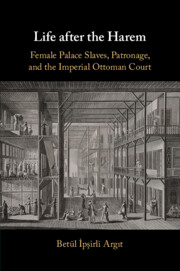Book contents
- Life after the Harem
- Life after the Harem
- Copyright page
- Dedication
- Contents
- Illustrations
- Maps
- Graphs
- Tables
- Acknowledgments
- Note on Usage
- Abbreviations
- Introduction
- 1 The Imperial Harem and Its Residents
- 2 Departure from the Imperial Palace and Changing Relationships with the Imperial Court
- 3 Marriage Patterns
- 4 Residential Districts and Relations with Society
- 5 Material World: Fortunes and Possessions
- 6 Charitable Activities: Architectural Patronage and Endowments
- Conclusion
- Appendix Residential Neighborhoods of Palace Women in intra muros Istanbul
- Bibliography
- Index
Conclusion
Published online by Cambridge University Press: 08 October 2020
- Life after the Harem
- Life after the Harem
- Copyright page
- Dedication
- Contents
- Illustrations
- Maps
- Graphs
- Tables
- Acknowledgments
- Note on Usage
- Abbreviations
- Introduction
- 1 The Imperial Harem and Its Residents
- 2 Departure from the Imperial Palace and Changing Relationships with the Imperial Court
- 3 Marriage Patterns
- 4 Residential Districts and Relations with Society
- 5 Material World: Fortunes and Possessions
- 6 Charitable Activities: Architectural Patronage and Endowments
- Conclusion
- Appendix Residential Neighborhoods of Palace Women in intra muros Istanbul
- Bibliography
- Index
Summary
Orientalist literature has evaluated the harem and its female slaves with a mix of fact, hearsay, and fantasy. In doing so, it has created a stereotype of the harem and the women living in it. The Ottoman imperial harem has come to symbolize several general fantasies: despotism, sexuality, female slavery, intrigue, extravagance, and the seclusion of women. Yet, extensive literature critical of Orientalizing discourses and Orientalist imagery has refuted the stereotyped orientalist impressions of harems and female slaves. But female slaves’ time in the harem was often only one part of their lives, and sometimes a remarkably small one. This book aimed to recapture the later chapters of their lives and to turn them from objects into real human subjects. I have studied various aspects of the lives of palace women who lived in different periods between the second half of the seventeenth and the end of the eighteenth centuries from the perspective of patronage relationship with the imperial court; in doing so, I have evaluated what the relationship between two sides interwoven through patronage – a relationship that began as a result of affiliation to the imperial court – meant in the long term for both the palace women as protégés and for the imperial household as patron (hâmî). This book thus follows female slaves of the Ottoman imperial harem after their manumission, and traces what it meant to be a palace woman in the Ottoman world. It explores the roles and importance of manumitted female palace slaves, both within the imperial court and in Ottoman society more broadly. As a study of manumitted female palace slaves in the context of Ottoman society and the imperial court, this book has recaptured the agency of lower-level Ottoman palace women.
- Type
- Chapter
- Information
- Life after the HaremFemale Palace Slaves, Patronage and the Imperial Ottoman Court, pp. 226 - 234Publisher: Cambridge University PressPrint publication year: 2020

